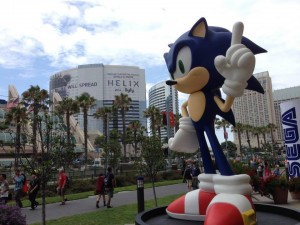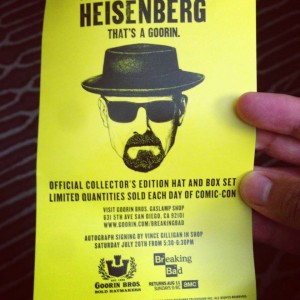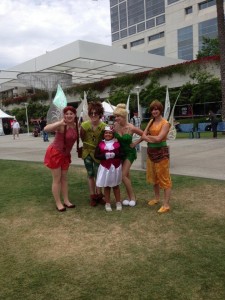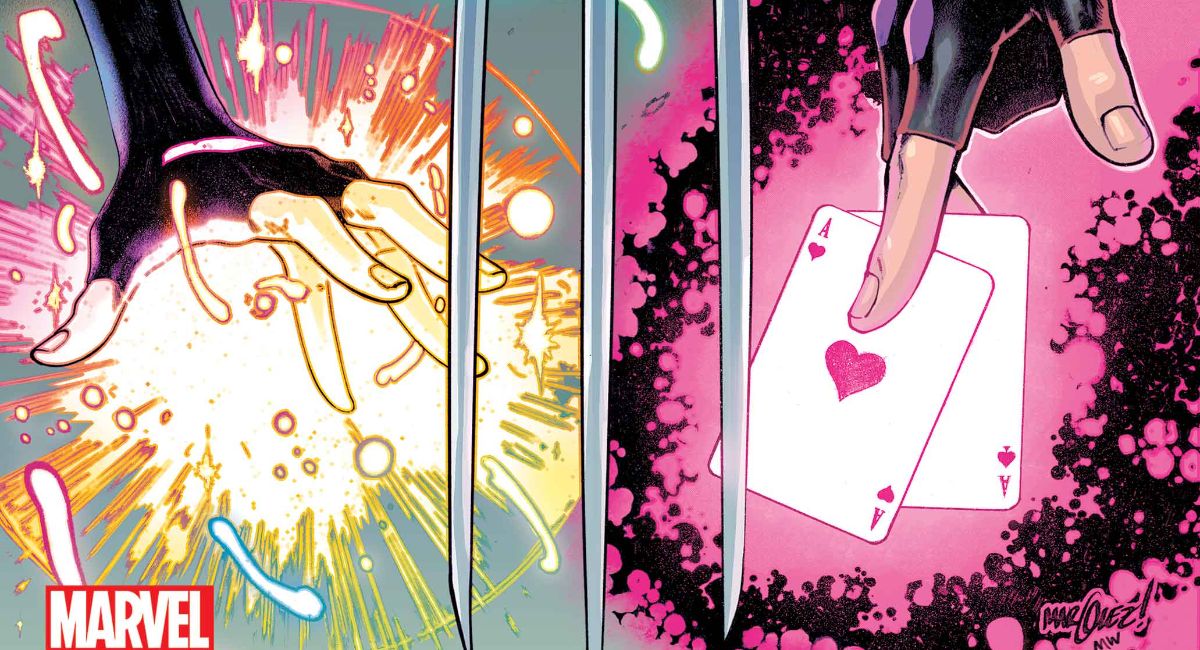By Bon Alimagno
I hadn’t been to San Diego Comic-Con in five or six years. I swore it off when I was walking through one of the halls, one that had become largely consumed by video game companies. The crowd those vendors attracted choked the aisles. I wanted to turn around to find the booth for some TV show, Heroes I think, but feared that any movement against the direction of the crowd that was carrying me away might get me trampled. In the years since I’d been encouraged to hear that crowd control and traffic movement were getting better. And having been out of comics for nearly two years I decided it might be time to finally experience Comic-Con’s particular brand of insanity from the perspective of a civilian, instead of one whose job for years had been to think that show floor was a suitable working environment.
So, to the bafflement of many of my old friends in the comics industry, I decided to vacation at Comic-Con, though focusing on the happenings outside the convention center – San Diego WITHOUT THE Comic-Con. I spent hours watching people dodge and weave around a zombie-laden obstacle course that took-over four levels of Petco Park. (Here’s a bit of the end of it.) I watched a dance party break out in front of two story balloons of the Teen Titans. There were events at nearby hotels, like the Xbox Lounge, and at pop-up spaces like the Godzilla Experience. A ship docked at the marina was turned into an Assassin’s Creed themed pirate vessel. Breaking Bad creator Vince Gilligan did a signing at a hat store selling the infamous Heisenberg hat that completed Bryan Cranston’s villainous look.
I did eventually go onto the show floor in pursuit of only two things: the hardcover edition of Jeremy Bastian’s Cursed Pirate Girl and that new Metroplex Transformer with the nifty Con-exclusive Phil Jimenez box art. While I was successful at the first, I was defeated in the second by Hasbro’s bizarre Wait-In-A-Line-To-Get-A-Ticket-To-Wait-In-The-Real-Line system. All in all I spent three hours on the show floor, which was all I could stand to be there. The problem though wasn’t that the show was still as big and crazy as it had always been. It was indeed better managed than I remembered it. The problem is that San Diego Comic-Con isn’t big enough — it needs to get bigger. Much bigger. It needs more people, more exhibitors, more spectacle. It needs more of San Diego.
People will complain that Comic-Con’s biggest problem is that it’s become a celebration of movies more than comic books. I think Comic-Con’s biggest problem is that it’s become a celebration of wasting time. The reasons anyone would go to a comic book convention usually involve meeting and greeting, buying and selling, discovering something new and cherishing unique experiences. But you need space for that. And you need time. So how to create more of both?
Now, I have come to view myself as a bit of a “Fixer.” People, whether at my current employer or out of it, might come to me with a problem, looking for a solution. I always start the conversation by asking what resources are available to address that problem, and when and how we can make use of them. In the case of San Diego Comic-Con, it’s most valuable resource is San Diego itself.
San Diego’s downtown is a perfect cocktail of waterfront, lively downtown and public transit that makes a city takeover not just possible but enjoyable. Unlike, say, New York Comic-Con, you won’t have to trudge blocks to get to the heart of the city, it’s literally across the street. And unlike most Cons the ridiculously pleasant year-round weather makes taking advantage of outdoor spaces like the Marina and Petco Park much more doable.
For too long the conversation about fixing San Diego has revolved around just building a bigger convention center – making it the center of the Comic-Con experience with everything outside of it in a kind of secondary orbit. Now is the time to flip that model over completely, to not fight the creeping of Comic-Con out into the city, but to encourage and enable it, to unleash it across the entire city, every available or underutilized part of it.
The one size fits all, buffet style badge isn’t going to work when you keep adding more and more things to the buffet. Instead choices need to be made about what absolutely belongs in the convention center and what could benefit and even flourish outside of it. With that in mind, let’s create two kinds of Comic-Con badges with differing levels of access.
First, create a new class of 50,000 badges for people who can experience only out of Convention Center events and exhibitors. These badges will be targeted at folks already thinking of not returning to the show, ones who would’ve been exhausted by the scene at the Convention Center and are looking for better access to publishers, toy companies and creators. Next, move those vendors out into the city. For starters, move all comic book publishers to Petco Park, perhaps even on the field itself with appropriate staging protecting the infield. Artist Alley could be moved either to concourses at Petco or situated somewhere along the waterfront, a sort of Artist Marina.
Next, how about the Con partner up with the city to facilitate the adoption of blocks or even streets by the major publishers, movie studios and toy companies? Imagine Marvel and DC, Image and Dark Horse filling unutilized spaces with pop-up storefronts, or galleries for signings, workshops and other meet and greet events. Imagine Hasbro and Mattel with their own pop-up stores for convention exclusives – selling goods the way Goorin Bros. teamed up with AMC and Breaking Bad to sell the Heisenberg hat. Have anchor points set up around the city like at the renovated Horton Plaza mall where panels and screenings can find an audience they wouldn’t otherwise at the convention center due to lack of space and priority.
All the above would be tied together with a San Diego Comic-Con Without the Comic-Con badge, which would be lower priced, but at the same time entitle badge holder access to all of these unique spaces and events.
Meanwhile, reduce the actual San Diego Comic-Con badge count and cap it around 90,000. Give these badge holders access to all the “Without The” spaces as well but essentially charge them more for access to the Convention Center itself. Actively take advantage of the fewer attendees by creating more room to maneuver with wider aisles. Emphasize the Convention Center as truly owned by the movie studios and video game companies, letting those exhibitors create even bigger, more spectacular booths and experiences.
Though Comic-Con is officially a non-profit, it’ll still need money to run all of this. I figure the ability to sell the new class of “Without The” Comic-Con badges would make up for the lost income from capping attendance at the Convention Center itself. Agreements can be made with restaurants, bars, etc. licensing the ability to act as official venues for “Without The” events, allowing them to gain customers they wouldn’t have otherwise. (Tavern Bowl, where the Tr!ckster pop-up was hosted and where I held #Tweetfolio Live, is an excellent example of a place of business getting increased traffic by relatively direct association with the Con.)
This is of course easier said than done. But I think if the show started actively questioning which exhibitors and events should actually be at the convention center and which could find a better home outside of it, you’d transform the entire experience into something more enjoyable for con goers and more fruitful for the city. If a set-up like this had been in place this year perhaps I would’ve gotten that Transformer after all.
Got ideas for how to transform San Diego Comic-Con? Tweet them to me at @karma_thief! #Tweetfolio returns next week with the recap of the #Tweetfolio Live event at SDCC.









The logistics of security and staff CCI would need to add to manage outside events for paying badge attendees, alone , would be mind boggling. The price of a Walking Dead survival ticket alone should tell you Petco Park is expensive for AMC to rent each year, add that on top of the $10-18million contract CCI has to pay the convention center. No way ticket prices for the show don’t go up to around $60 a day. The overcrowding can’t be fixed by CCI vomiting out into the city. Going inland any further and you’re in as bad an area as downtown L.A.
There are two solutions to the problem 1) fix the badge situation, a reliable staff source told me that out of 150,000 possible badges only a little over 60,000 are actually sold to the public. The rest go to exhibitors, their guest, media, and “professionals”. Selling 120,000 to general public would drive down the cost for paying attendees and cut down on the –not actual– professionals, and bloggers who get in for free instead of legit press like Comics Beat.
A second and more bold option is for CCI to have separate shows during the summer for Film&TV, games, and comics respectively. You could have 3 Saturday Sundays in a row each for a different genre of pop culture. Separating the clashing crowds would open floor space and reduce CCI’s staff needs. Contract cost stays around the same amount because the days would almost be the same but the shows become more manageable and enjoyable. The Gaslamp area still sees its boom but for longer periods of time.
What do I know I’m just writing this cause I can’t sleep.
This is essentially what SXSW does here. Use the convention center to host panels and really large events, then every bar downtown is a music venue and every theater is a film venue. Now, secondary event spaces host other parts of the convention along with a few hotels where industry folks tend to stay/congregate.
Then the pop up, non con exclusive events take nearly everything else in the city.
And there are multiple levels of access for everything. 3 badge levels, wristbands, individual tickets, etc.
The 2 shows are very similar but I feel like sxsw is maybe 5 years ahead of sdcc in how it is run and connected to the city.
D — let TWICE AS MENY PEOPLE IN to an already almost unpassable hall?
NO THANKS.
NO one has responded to my theory that the Hollywood contingent goes home on Saturday morning but I think Thursday and Friday are more frantic than the legendary “Saturday.”
We do need a bigger hall, we need more offsites, we need more comics, to quote the little girl in the AT&T commercial “We want more, we want more!”
Three weeks. And attendees can only buy a badge for one of them. Some programs could be repeated each week, some wouldn’t. Vendors could set up for one, two or three weeks – there’s a waiting list already anyway. Sure, not everybody would have the opportunity to see everything, but even the most energetic person only sees about 5% of the con now.
Before anyone continues, read this:
http://www.utsandiego.com/news/2013/Jul/17/comic-con-rent-discount-convention-center/
Yup… How much to rent the convention center in 2013? $188K
That’s after the discount. $480K otherwise.
If you really want to dig into CCI financials, they are registered non-profit, and must file public tax returns.
Google: “Nonprofit Comic-Con Reports Nearly $10 Million Cash in the Bank”
“In its most recent tax filing—submitted to the IRS in July 2011—the San Diego Comic Convention reported gross receipts of $10.16 million and expenses of $9.1 million.” (Patch)
$5 Million from memberships, $4.7M from exhibitors.
And… they’ve got an “endowment” of $10 Million which can be used to fund other “educational” missions.
—
Um… Here’s some old ideas I’ve proposed:
1) Big exhibitors should rent the hotel ballrooms. Keep a foothold on the main floor, but move all of your exhibition to the ballroom. YOU control the security, the hours of operation, what the crowd sees and when. Want to keep the ballroom open 24/7? Go right ahead!
2) The Hyatt has lots of ballrooms. There’s even a basement exhibition hall. Non-Con organizers (think Tr!ckster) could rent a row of meeting rooms and hold their own parallel events. Rare art and collectibles. Artists Alley. Furries. Heck, run a parallel con during the Con! Granted, hotels might be a bit difficult to get a hold of that weekend… maybe rent a high school!
3) Analyze what Erlangen and Angouleme do by spreading events out into the city. Since CCI is a non-profit, they should be engaged with other non-profits on their educational mission. Talks at the library, workshops at Liberty Station…
4) Clone the Con and place it in Las Vegas in November. Start with one of the huge hotel convention centers (which has more space than San Diego), then expand into other hotels. Each hotel is a different fandom, a different ticket. (Yup… you can charge people twice, triple, to attend the show!) Hollywood in one hotel, comics in another, furries all the way over on Fremont (I kid!)…
5) You all realize that regional shows are growing, and approaching CCI numbers, right? Javits will probably hit 125K this year (or at least feel like it). C2E2 has tons of space not yet used. (Next year: South Hall!) WonderCon, in Anaheim, only uses one hall currently. That building is spacious, vertical, and can handle crowds. (This weekend: D23 takes over the entire building.) Lots of space in Moscone, if San Francisco ever returns CCI’s phone calls.
So, San Diego might have the glitz now, but it’s quite possible that regional shows will follow the evolutionary path of San Diego, and some of the pilgrims will journey elsewhere.
Three weeks:
exhibitors would have to PAY employees for those weeks. Plus pay for hotel rooms, show rental, flying in talent…
Ever worked retail during the Holidays? Picture Black Friday. Now imagine TWENTY-ONE Black Fridays in a row. Now imagine the mental state of employees working the booths.
I ATTEND conventions, and even I am weary at the end of each day. Not from walking, but from using my brain constantly, sometimes on turbo.
Madness.
Probably can’t do anything on the field during baseball season. It would harm the integrity of the playing surface.
moe.
My perspective on the 990 was somewhat different – not that Comic Con has an abundance, but that given the scale the amount it clears is somewhat low. It wouldn’t take much to flip from profit to loss – fewer sponsorships, a dip in attendance, having to rely on more paid staff as opposed to volunteers. Sure, it all sounds unlikely, but 10 years ago law schools were a growth industry.
That isn’t to say Comic Con is doing badly – not at all. It’s a model of nonprofit efficiency (really) and is keeping prices lower than it could justifiably charge.
Comments are closed.